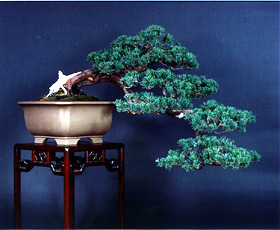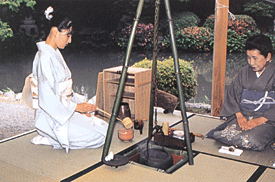 |
Web Dojo an online service of the Nippon Karate-do/Kobudo Seishin-Kan |
 |
| You are here: Home > Philosophy > Bunbu Ryodo | ||
|
". . . to appreciate the beauty of a single dandelion or chirping bird when surrounded by urban squalor . . . to take solace in a close friendship while facing job loss or personal tragedy . . . to find the strength to prevail in the words of a great philosopher or theologian . . ."
"The same symmetry of posture that produces beauty also produces the balance needed to maximize its stability and control. The same muscles and skeletal structure that produce graceful movement also produce optimal striking power and speed." |
Bunbu Ryodo is the traditional Japanese approach to martial arts training. A somewhat literal translation would be: "The Dual Path of Cultural and Martial Arts," with the nearest Western equivalent being, "The Way of the Pen and the Sword." Bunbu Ryodo refers to the necessity of harmonizing the physical training of martial arts with the cultivation of appreciation for, or skill in, aesthetic arts.
Martial arts are indeed arts, and we do them a disservice if we ignore their artistic elements. The correct posture and balance of the body when performing a technique in karate-do has all of the artistic merit and complexity of a graceful dance movement, the exquisite pose of a sculpture, or the delicate composition of a fine painting. As important as appreciating the artistry of karate-do purely for its intrinsic beauty is the fact that a study of the artistic elements of a technique will reveal deeper subtleties of bio-mechanics that will increase its effectiveness for self-defense. The same symmetry of posture that produces beauty also produces the balance needed to maximize its stability and control. The same muscles and skeletal structure that produce graceful movement also produce optimal striking power and speed.
At the Seishin-Kan, we therefore encourage all serious students of traditional martial arts to devote a significant portion of their training to aesthetic or cultural arts. This study need not be devoted to Japanese culture and arts. It could as easily involve jazz, ska, hip-hop, or rock music . . . modern dance, ballet, or aboriginal folklore . . . modern American poets, spy novels, or classical European literature . . . It must be something that interests and involves you. The advantage of studying some additional forms of Japanese culture, however, is that by studying it, you will simultaneously deepen your understanding of the philosophy and aesthetics of Japanese martial arts. The reason should now be obvious: bunbu ryodo has been a part of traditional martial arts training for centuries, so traditional martial arts have been strongly influenced by these other aesthetic and cultural art forms and vice versa. Some Japanese cultural traditions to consider studying:
Coming Soon: Individual resource pages for each of the above. |
|
|
Please give us your opinion of this article.
Was it meaningful to you? Did it help you better understand martial
arts? Did it help you see how martial arts can improve your daily
life? Please give us your comments in our Karate Discussion Forum. |
||
|
Home | Membership | Privacy Policy | Webmaster | Contact Us | Guest Book | JKI Home | Store |
© 2003 Leonard J. Pellman |
|
Free counters provided by Honesty.com.
 Most of the great martial
arts masters of the 16th through 20th centuries were also masters
of at least one form of cultural or aesthetic arts. They were
painters, sculptors, philosophers, poets, or well-studied in the
literary classics of their era. Quite often, they were masters of
the Japanese tea ceremony (cha no yu)
or flower arrangement (ikebana), or of
a musical instrument like the shakuhachi
(bamboo flute). Many cultivated bonsai
-- miniature trees that can take generations to fully train and
shape -- or spent decades creating a classical Japanese garden.
Their ability to wreak sudden violence was tempered by an equal
appreciation for the serene and contemplative aspects of human life and
its place in nature.
Most of the great martial
arts masters of the 16th through 20th centuries were also masters
of at least one form of cultural or aesthetic arts. They were
painters, sculptors, philosophers, poets, or well-studied in the
literary classics of their era. Quite often, they were masters of
the Japanese tea ceremony (cha no yu)
or flower arrangement (ikebana), or of
a musical instrument like the shakuhachi
(bamboo flute). Many cultivated bonsai
-- miniature trees that can take generations to fully train and
shape -- or spent decades creating a classical Japanese garden.
Their ability to wreak sudden violence was tempered by an equal
appreciation for the serene and contemplative aspects of human life and
its place in nature. This artistic aspect of the martial arts is one more way in which
traditional martial arts are particularly germane to the 21st Century. We live in turbulent times.
We read or hear daily of urban violence and decay, terrorism and
war, corruption in government, and contamination of the
environment. Our major institutions appear to be failing. An 8th grader
100 years ago was better educated than most of today's college
graduates. Markets are manipulated to produce fuel and power
shortages. Chemical additives in our food, beverages, and air are
killing us, yet we enjoy greater longevity than ever before in
history. How? By chemical additives and organ replacements that are making people artificial! Bunbu Ryodo
helps us find serenity in the midst of this turmoil . . . to
appreciate the beauty of a single dandelion or chirping bird when
surrounded by urban squalor . . . to take solace in a close
friendship while facing job loss or personal tragedy . . . to find the strength to
prevail in the words of a great philosopher or theologian.
This artistic aspect of the martial arts is one more way in which
traditional martial arts are particularly germane to the 21st Century. We live in turbulent times.
We read or hear daily of urban violence and decay, terrorism and
war, corruption in government, and contamination of the
environment. Our major institutions appear to be failing. An 8th grader
100 years ago was better educated than most of today's college
graduates. Markets are manipulated to produce fuel and power
shortages. Chemical additives in our food, beverages, and air are
killing us, yet we enjoy greater longevity than ever before in
history. How? By chemical additives and organ replacements that are making people artificial! Bunbu Ryodo
helps us find serenity in the midst of this turmoil . . . to
appreciate the beauty of a single dandelion or chirping bird when
surrounded by urban squalor . . . to take solace in a close
friendship while facing job loss or personal tragedy . . . to find the strength to
prevail in the words of a great philosopher or theologian.